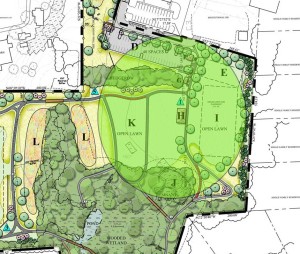Supervisors agree to apply for grant to allow construction of phase one; local neighbors argue against any use beyond passive recreation
By Mike McGann, Editor, UnionvilleTimes.com

Phase 1 of the Unionville Park project would build parking, a limited trail and an open lawn near the Po-Mar-Lin fire house.
EAST MARLBOROUGH — Despite objections from neighbors, the board of township supervisors unanimously voted Monday night to move forward on plans to build Unionville Park — and apply for a grant to help fund the first phase of construction.
While numerous supporters spoke briefly in support of the park plan as presented, the vast majority of speakers during Monday night’s public hearing were neighbors of the property, primarily from Monitor Place and Merrimack Place, which sits to the south of the property. They listed their objections to the park being anything than a passive, trail-oriented facility. They argued against a playground, open playing fields any features that might attract large numbers of visitors, creating noise and traffic in their neighborhood.
Supervisors chair Cuyler Walker told the packed room that he and his colleagues were sensitive to the needs and desires of the neighbors, but as the township spent roughly $1.4 million to purchase the property in an effort to prevent the building of some 80 townhouses on the property, that the board needed to weigh those needs and desires against those of the wider population of the township.
Supervisor Robert Weer was more blunt.
“Three times as many people as this made it loud and clear that they did not want townhouses,” Weer said. “As some of you know, I grew up on a house right there, and some years ago, our family discovered that there were plans to build a fire station. We didn’t go to the township to complain that our lifestyle would be disrupted. What they did was become part of the fire company, and for four generations we’re still active in that organization.
“I think, some years from now, we’ll be looking back and be proud of what we’ve done here. This gives us an opportunity to move forward, and I’m thinking down the long road for the future of East Marlborough township.”
Lisa Thomas, a partner in the Glackin Thomas Panzak firm that developed the park plan, ran through the details of the plan, focusing on phase one, which will the area closest to the Po-Mar-Lin fire station on Doe Run Road. Thomas explained the initial phase would build a parking lot, planned for 48 spaces, over the existing storm water retention basin, with a new underground basin built as part of a revised storm water management plan for the site.
A modest portion of the trail would be constructed, completing one loop as well as one open lawn area, which could be used for multiple purposes, including sports practices. The first phase would cost $1.015 million to build. The plan is for roughly $600,000 to come from state and county grants, while the township would pay about $400,000 from its open space funds for the project. If the township is not awarded the grants, the project would be put on hold.
“I don’t think we’d start to work on phase one,” Walker said. “No township dollars are committed in the absence of of the grant money.”
All three elements were challenged, not just be the residents, who argued that just the trails should be built, with little or no parking and the fields should not be built, but by members of the board, who questioned the need for so much parking, particularly in the first phase of the project.
The parking area was designed as it was, Thomas said, because it was made clear that there could not be extra parking at the Po-Mar-Lin lot adjacent or at the nearby post office or feed store. The lot, she said, is expected to cost about $230,000, with about $170,000 being paving costs. Walker, in particular asked whether it could be scaled down in the initial phase to see if there would be enough demand — much he noted, as the township has done with private developers — build some of the parking, and leave aside space for expansion if needed. Thomas said it could be done, but would ultimately add to the final cost of the entire project.
“No outcome is ever perfect,” Walker said. “No one is ever perfectly satisfied.” he assured that the neighbors would continue to be part of planning process and be kept in the process of developing the project and making adjustments to the plan.






